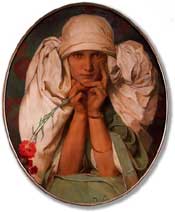| |  | Alphonse Mucha |  |
| "The purpose of my work was never to destroy but always to create, to construct bridges, because we must live in the hope that humankind will draw together and that the better we understand each other the easier this will become." *** Alphonse Mucha (1860-1874) was born in Ivancice, Moravia. Mucha's style is virtually synonymous with Art Nouveau and he is one of the most imitated artists and designers of all time. In addition to commercial art, jewelry design, interior decoration, sculpture and stage design, Mucha experimented with lettering and calligraphy to produce excellent source material for unique typefaces. |  |
Mucha moved to Paris in 1890, where he studied at the Academie Julian. It was the height of Impressionism and the beginnings of the Symbolists and Decadents. He shared a studio with Gauguin for a bit after his first trip to the south seas. Mucha's style was based on a strong composition, sensuous curves derived from nature, refined decorative elements and natural colors. He became the star of the poster-art movement under the patronage of Sarah Bernhardt, and his fame spread around the world. Several trips to American resulted in covers and illustrations in a variety of U.S. magazines. Mucha was always a patriot of his Czech homeland and considered his success a triumph for the Czech people as much as for himself. In 1909 he was commissioned to paint a series of murals for the Lord Mayor's Hall in Prague. He also began to plan out "The Slav Epic", a series of great paintings chronicling major events in the Slav nation. This project embraced 18 years of his life. He became the father of a slavic arts and crafts movement which combined elements of Art Nouveau with classic national themes. When the Germans invaded Czechoslovakia, he was still influential enough to be one of the first people arrested by the Gestapo. During his interrogation, the aging artist became ill with pneumonia. Though released eventually, he may have been weakened by this event and died shortly thereafter on July 14, 1939. |
|
| |
|  | | "Biscuits ChampagneLefèvreUtile" (1896) Lithograph, 52 x 35.5 cm - 20.47 x 13.98 in. Private collection. | |  | 
|  |  | "Jaroslava" (1920) Oil on canvas, 76 x 60 cm - 28.74 x 23.62 in. Private collection. | | | 
|  |  | "Autumn" 1896) Panel. Private collection. | |  | 
|  |  | "Summer" (1896) Panel. Private collection. | | | 
|  |  | "Flower" (1897) Lithograph, 66.2 x 44.4 cm - 26 x 17.48 in. Private collection. | | | 
|  |  | "Moët & Chandon Crémant Impérial" (1899) Lithograph, 60.8 x 23 cm - 23.94 x 9 in. Private collection. | | | 
|  |  | "Selfportrait" (1907) Oil on canvas, 28.5 x 44 cm - 11.22 x 17.32 in. Private collection. | |  | 
|  |  | "The Artist" (1920) Oil on canvas laid down on board, 54.6 x 57.2 cm - 21.5 x 22.52 in. Private collection. | | | 
|  |  | "The Apotheosis of the Slavs" (1926) Oil on canvas. Private collection. | |  | 
|  |  | "Winter Night" (1920) Oil on cardboard, 73 x 60 cm - 28.74 x 23.62 in. Private collection. | | | 
|  |  | "The Enchantress" Oil On Canvas, 65.4 x 49.6 cm - 25.75 x 19.53 in. Private collection. | | | 
|  |  | "North Star" (1902) Pencil wash, 21.7 x 56 cm - 8.54 x 22 in. Private collection. |
| Text source: unknown. | |
|
|